In Bayern’s opening Champions League match of the season, they took on Diego Simeone’s usually sturdy Atletico Madrid side.
Under Simeone, Los Cochoneros have a reputation for being solid, aggressive, and resolute, but against the defending tournament champions, they were powerless to resist against the devastating front line of the team from Munich.
That, perhaps more than any other result so far this season, proved they are continuing where they left off from their historic treble-winning 2019/20 season.
Line-ups
Bayern (4-2-3-1): Manuel Neuer; Lucas Hernandez, David Alaba, Niklas Sule, Benjamin Pavard; Leon Goretzka, Joshua Kimmich; Kingsley Coman, Corentin Tolisso, Thomas Müller; Robert Lewandowski.
Atleti (4-4-2): Jan Oblak; Renan Lodi, Felipe, Stefan Savic, Kieran Trippier; Yannick Carrasco, Koke, Hector Herrera, Marcos Llorente; Luis Suarez, Joao Felix.
Bayern in possession
Bayern patiently built from the back as expected, using an asymmetrical 4-3-3/3-4-3, with Hernandez usually playing like a third CB and Sule staying wide on the right, while Pavard stayed up high and did not participate much in the build-up. Kimmich was the sole pivot who roamed between Atleti’s first two lines to receive and distribute the ball.
Atleti pressed in a mid-to-high block 4-4-2. Their front two did not press intensely, but rather stayed around the middle. They tried to keep a compact midfield, but the wide midfielders were instructed to check the Bayern full-backs’ movements (and ideally to try to stay lower than their assigned opponent). Hence, Carrasco was often lower than Llorente, which limited Carrasco’s involvement in counterattacking situations. When defending, Atleti patiently waited for certain pressing triggers (e.g. difficult passes, bad touches).
Bayern’s centre-backs were under little pressure, but the wide players would be closed down as soon as they got the ball. Any player getting the ball between Atleti’s first two lines were usually closed down hard too, as Atleti used their compact shape to suffocate the ball-carrier.
Here, Hernandez’s pass to Kimmich triggered an intense press from Koke, as Atleti players had formed a circle around the German and blocked his passing lanes towards Alaba and Hernandez.
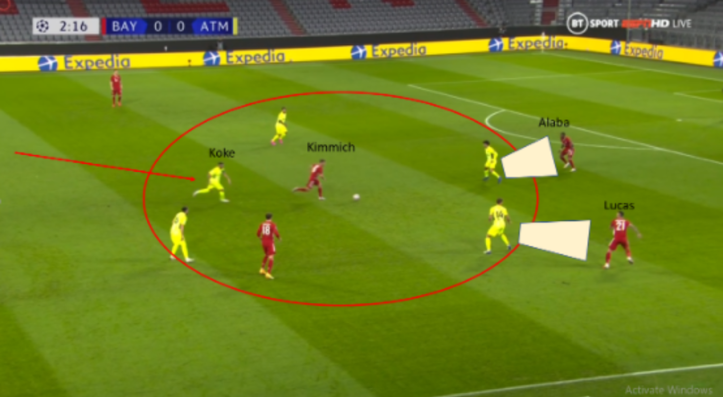
An option for Bayern to not fall into Atleti’s pressing trap described above was to combine through either wing. Atleti’s great compactness also helped them overload the ball side instantly. Koke and Herrera’s defensive awareness and work rate were key to this. The duo were in the top three for distance covered in the match.
Here, Coman and Lewandowski tried to combine through the left wing, but Atleti players made things difficult by overloading the ball area, and Koke beat Lewandowski in the loose ball duel.
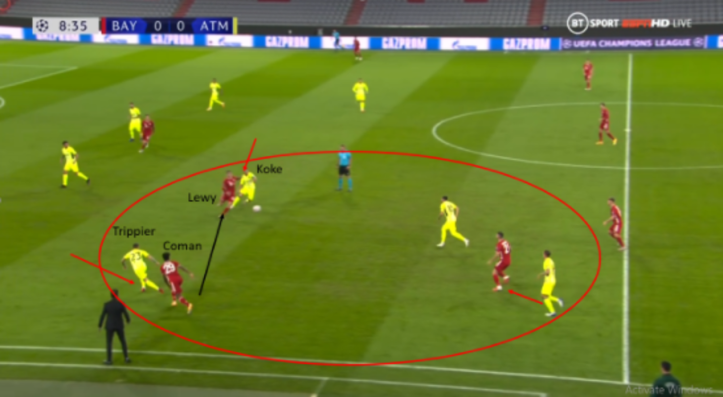
Such overloads also helped Atleti counter better. To combat Bayern’s aggressive counterpresses, Atleti looked to combine quickly with their men around the ball, something they definitely trained a lot on with rondo exercises.
Here, Atleti recovered possession and had a lot of men around the ball. A quick combination between Koke, Trippier and Herrera helped them escape Bayern’s counterpress. As Bayern’s shape was drawn toward the ball side, space opened up on the far side for Lodi to exploit. The sequence ended with a cross from Lodi.
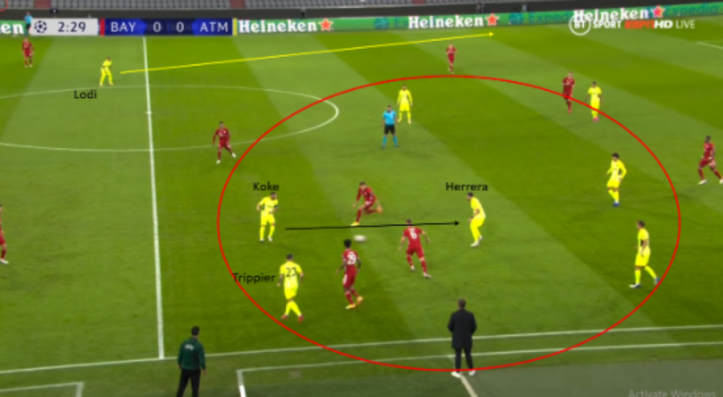
If Bayern managed to pass through these overloads, space would open up on the far side for Coman or Pavard - both pacey players - to instantly exploit and try to combine through that wing to send a cross in. Quick attacks/counters were a main weapon for Bayern with the pace of Coman, Tolisso and Pavard, and the great understanding between the front players.
Should Bayern push Atleti back into their own half, they looked like an asymmetrical 4-2-3-1 or 4-2-4. The speedy Tolisso was Bayern’s highest midfielder and made a lot of runs into the box, while Kimmich and Goretzka stayed deeper, effectively a double pivot. Up front, Bayern’s front four were very flexible in their positioning and exchanged their positions smartly to disrupt Atleti’s shape and opened progressive pass options for Kimmich and the back three. When the ball was in Atleti’s half, Coman and Pavard were the ones keeping width for the German side..
In their own half, Atleti retreated to their infamous, narrow 4-4-2 flat system. Similar to their style when defending in Bayern’s half, Atleti patiently waited for pressing triggers to close down space around the ball. The below image displays a typical example. Coman was about to receive the ball between the lines and was instantly closed down by Atleti’s centre-backs and double pivot, while the wide midfielders also provided support. They wanted to prevent Bayern progressing through central combinations, something they are clearly good at.
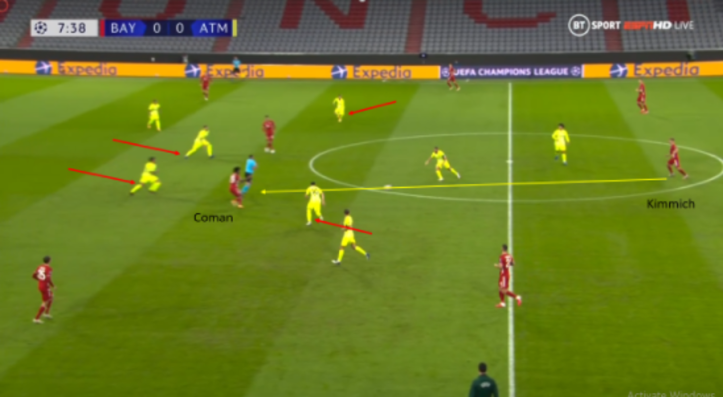
Such aggressive movements from Atleti’s centre-backs disappeared as the match went on. Bayern used their front four to pin’s Atleti’s back four. Atleti’s midfield had to drop deep, leaving Felix and Suarez - both not active pressers anyway - rather isolated. If the midfield kept staying high to press, the likes of Kimmich and Alaba could easily find a front player between the lines - the front four would then combine to create scoring chances. Therefore, Bayern’s defenders and double pivot comfortably dictated play. Some exchanges of passes would open up space on either wing, where Bayern would then combine and cross the ball.
In these situations, Atleti would commit a lot of men back into their box. Bayern already had many players near the box, and would all instantly make runs to get on the end of these crosses - their positions varied, making it hard for Atleti to defend - while Hernandez and the double pivot stayed just outside the box for second balls. Lewandowski often moved wide to engage in aerials with a full-back, while his teammates forced the back four narrow with their central movements. In the below example, Tolisso, Coman and Pavard’s presence in the box left Lewandowski unmarked at the far post, and the Polish striker almost scored from Muller’s cross. Numbers in and around the box made it easier for Bayern to counterpress and restart their attack.
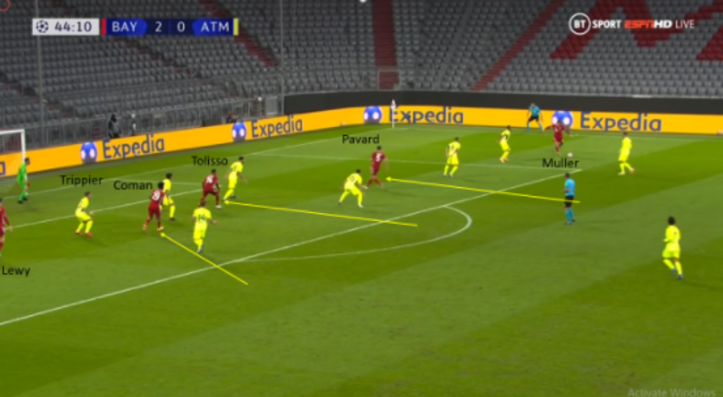
With multiple aerial threats, Bayern created many chances (at least two big chances) from crosses, from both open play and set-pieces. Their crossing accuracy was 30% from 20 attempts - quite impressive considering the aerial quality of their opponents.
Atletico in possession
Atleti didn’t choose to build from the back against a strong high-press side like Bayern. A common way to progress the ball was having the players overload a certain area to fight for the ball after a long kick from Oblak. This suited Atleti’s narrow style. Here, Suarez won the first ball from Oblak’s pass. Atleti’s players gathered around the ball to fight for it.
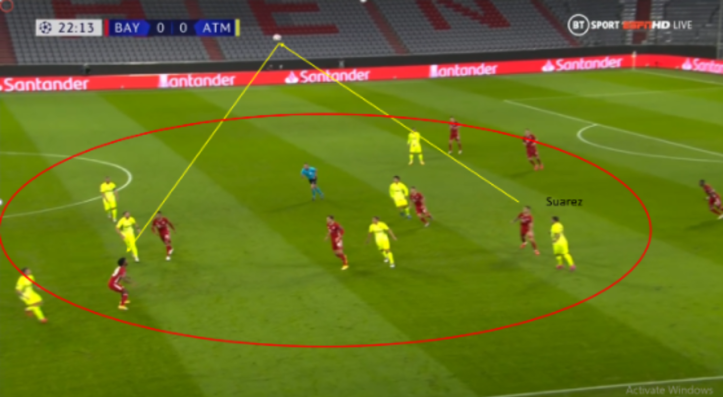
Should they win the second ball, they would then combine short to beat Bayern’s press (as described above). They mostly attacked through the wings, with players overloading a small area to combine. Many such combinations successfully created a real danger, thanks to the technical quality of Koke, Carrasco, and Felix. They would then try to finish the attack by ground crosses (while Bayern preferred floated ones) or direct shots. However, Atleti’s quality on the final ball was nowhere near Bayern’s level. Carrasco made bad decisions when given the chances, while Lodi and Trippier’s crosses were terrible (0 accurate cross from 11 attempts in total). It has to be said that Atleti had few men trying to get on the end of those crosses.
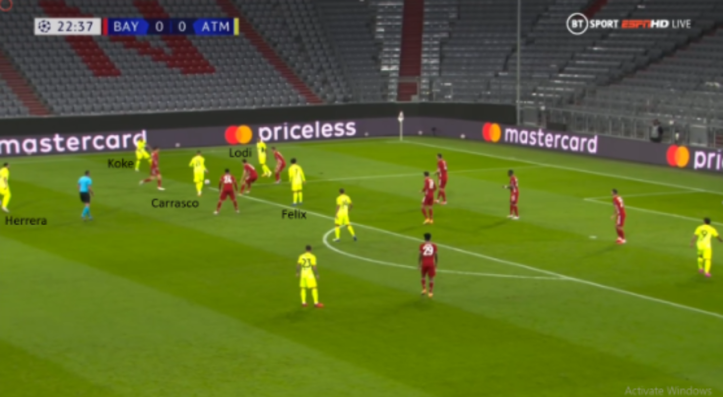
However, Atleti sometimes failed to play through Bayern’s counterpresses - typically with Bayern players moving to suffocate the ball-carrier by blocking all of his passing lanes and were punished immediately. Here, pressure from three Bayern players made Llorente overhit his back pass to Herrera. Tolisso and Lewandowski did well to intercept Herrera’s hasty back pass. Bayern scored just a few seconds later.
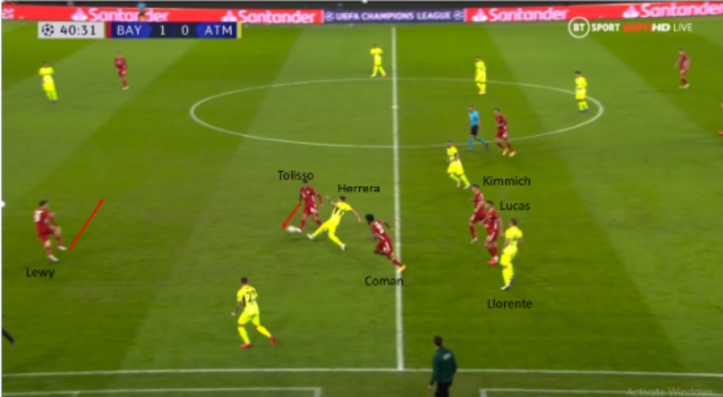
Conclusion
Ultimately, it was Bayern’s superior clinical decision making in the final third which gave them the advantage. The best team in the world made their opponents pay for even the smallest mistake. Atleti’s final ball was worryingly lacking, but the great combinations they displayed may work wonders against smaller sides and lay the foundation for their success in this season’s LaLiga.

 Robert Lewandowski
Robert Lewandowski  Luis Suárez
Luis Suárez  Thomas Müller
Thomas Müller  Kingsley Coman
Kingsley Coman  Bayern
Bayern  Atletico Madrid
Atletico Madrid 










